A Bibliometric Analysis of the Literature on Food Industry Supply Chain Resilience: Investigating Key Contributors and Global Trends
Abstract
1. Introduction
2. Data Source and Methodology
3. Findings: Bibliometric Analysis Results
3.1. Publication by Year
3.2. Contribution by Journals
3.3. Research Areas on Food Industry Supply Chain Resilience
3.4. Country Analysis
3.5. Influence of Authors
3.6. Most Relevant Contributions
4. Analysis of Research Trends
4.1. Keyword Analysis of Research Hotspots on Food Supply Chain Study
4.2. Cluster Analysis
5. Research Gaps and Future Research Opportunities
6. Conclusions
Author Contributions
Funding
Informed Consent Statement
Conflicts of Interest
Glossary
| Blockchain technology | A digital ledger system that allows for secure and transparent tracking of transactions. |
| Carbon footprint | The total amount of greenhouse gases that are emitted through the production and consumption of goods and services. |
| Circular economy | An economic system that aims to minimize waste and make the most of resources by reusing and recycling materials. |
| Digital technologies | Technologies that use digital information and communication to improve efficiency and productivity. |
| Food security | The state of having reliable access to sufficient, safe, and nutritious food. |
| Food supply chain systems | The network of interconnected entities involved in the production, processing, packaging, storage, transportation, and distribution of food products from the farm to the table. This includes farmers, suppliers, manufacturers, wholesalers, retailers, and consumers, as well as the infrastructure and technologies that facilitate the movement of food products through the supply chain. |
| Food systems resilience | The ability of the food system to withstand and recover from disruptions. |
| Food waste | The disposal of food products that are still safe and nutritious for consumption. |
| Industry 4.0 | The integration of advanced technologies, such as automation, data analytics, and artificial intelligence, into the manufacturing process. |
| Precision agriculture | The use of sensors and GPS to collect data on soil conditions, weather, and crop growth to optimize farming practices. |
| Precision farming | A type of farming that uses data analytics and technology to optimize crop yields and reduce waste. |
| Public health | The overall health and well-being of a population. |
| Risk management | The process of identifying, assessing, and mitigating risks to the supply chain. |
| Seafood supply chain | The process of moving seafood products from producers to consumers. |
| Smart agriculture | The use of technology, such as drones and sensors, to monitor crop health and improve efficiency. |
| Supply chain disruptions | Interruptions or delays in the process of moving products from producers to consumers. |
| Sustainability | The ability to meet the needs of the present without compromising the ability of future generations to meet their own needs. |
| Traceability | The ability to track the movement of products or ingredients throughout the supply chain. |
| Transparency | The degree to which information is readily available and accessible. |
References
- Ivanov, D. Viable supply chain model: Integrating agility, resilience and sustainability perspectives—Lessons from and thinking beyond the COVID-19 pandemic. Ann. Oper. Res. 2020, 319, 1411–1431. [Google Scholar] [CrossRef] [PubMed]
- Aday, S.; Aday, M.S. Impact of COVID-19 on the food supply chain. Food Qual. Saf. 2020, 4, 167–180. [Google Scholar] [CrossRef]
- Mu, W.; van Asselt, E.; van der Fels-Klerx, H. Towards a resilient food supply chain in the context of food safety. Food Control. 2021, 125, 107953. [Google Scholar] [CrossRef]
- Reddy, V.R.; Singh, S.K.; Anbumozhi, V. Food Supply Chain Disruption due to Natural Disasters: Entities, Risks, and Strategies for Resilience. ERIA Discuss. Pap. 2016, 18, 1–37. [Google Scholar]
- Peck, H. Drivers of supply chain vulnerability: An integrated framework. Int. J. Phys. Distrib. Logist. Manag. 2005, 35, 210–232. [Google Scholar] [CrossRef]
- Marusak, A.; Sadeghiamirshahidi, N.; Krejci, C.C.; Mittal, A.; Beckwith, S.; Cantu, J.; Morris, M.; Grimm, J. Resilient regional food supply chains and rethinking the way forward: Key takeaways from the COVID-19 pandemic. Agric. Syst. 2021, 190, 103101. [Google Scholar] [CrossRef]
- Sarker, N.I.; Wu, M.; Chanthamith, B.; Yusufzada, S.; Li, D.; Zhang, J. Big Data Driven Smart Agriculture: Pathway for Sustainable Development. In Proceedings of the 2019 2nd International Conference on Artificial Intelligence and Big Data (ICAIBD), Chengdu, China, 25–28 May 2019; pp. 60–65. [Google Scholar] [CrossRef]
- Astill, J.; Dara, R.A.; Campbell, M.; Farber, J.M.; Fraser, E.D.; Sharif, S.; Yada, R.Y. Transparency in food supply chains: A review of enabling technology solutions. Trends Food Sci. Technol. 2019, 91, 240–247. [Google Scholar] [CrossRef]
- Ali, I.; Arslan, A.; Chowdhury, M.; Khan, Z.; Tarba, S.Y. Reimagining global food value chains through effective resilience to COVID-19 shocks and similar future events: A dynamic capability perspective. J. Bus. Res. 2021, 141, 1–12. [Google Scholar] [CrossRef]
- Wagner, S.M.; Neshat, N. Assessing the vulnerability of supply chains using graph theory. Int. J. Prod. Econ. 2010, 126, 121–129. [Google Scholar] [CrossRef]
- Ouko, K.O.; Gwada, R.O.; Alworah, G.O.; Onganga, Z.M.; Ochieng, S.V.; Ogola, J.R.O. Effects of COVID-19 pandemic on food security and household livelihoods in Kenya. Rev. Agric. Appl. Econ. RAAE 2020, 23, 72–80. [Google Scholar] [CrossRef]
- Savary, S.; Akter, S.; Almekinders, C.; Harris, J.; Korsten, L.; Rötter, R.; Waddington, S.; Watson, D. Mapping disruption and resilience mechanisms in food systems. Food Secur. 2020, 12, 695–717. [Google Scholar] [CrossRef]
- Rueda, X.; Garrett, R.D.; Lambin, E.F. Corporate investments in supply chain sustainability: Selecting instruments in the agri-food industry. J. Clean. Prod. 2017, 142, 2480–2492. [Google Scholar] [CrossRef]
- Maghsoudi, A.; Zailani, S.; Ramayah, T.; Pazirandeh, A. Coordination of efforts in disaster relief supply chains: The moderating role of resource scarcity and redundancy. Int. J. Logist. Res. Appl. 2018, 21, 407–430. [Google Scholar] [CrossRef]
- Okello, J.O.; Were, S. Influence of supply chain management practices on performance of the Nairobi Securities Exchange’s listed, food manufacturing companies in Nairobi. Int. J. Soc. Sci. Entrep. 2014, 11, 107–128. [Google Scholar]
- Hecht, A.A.; Biehl, E.; Barnett, D.J.; Neff, R.A. Urban Food Supply Chain Resilience for Crises Threatening Food Security: A Qualitative Study. J. Acad. Nutr. Diet. 2019, 119, 211–224. [Google Scholar] [CrossRef]
- hossein Nikou, S.; Selamat, H. Risk management capability within Malaysian food supply chains. Int. J. Agric. Econ. Dev. 2013, 1, 37–54. [Google Scholar]
- Dania, W.A.P.; Xing, K.; Amer, Y. Collaboration behavioural factors for sustainable agri-food supply chains: A systematic review. J. Clean. Prod. 2018, 186, 851–864. [Google Scholar] [CrossRef]
- Fischer, C. Trust and communication in European agri-food chains. Supply Chain Manag. Int. J. 2013, 18, 208–218. [Google Scholar] [CrossRef]
- Aruoma, O.I. The impact of food regulation on the food supply chain. Toxicology 2006, 221, 119–127. [Google Scholar] [CrossRef]
- Vlajic, J.V.; van der Vorst, J.G.; Haijema, R. A framework for designing robust food supply chains. Int. J. Prod. Econ. 2012, 137, 176–189. [Google Scholar] [CrossRef]
- Ishfaq, R. Resilience through flexibility in transportation operations. Int. J. Logist. Res. Appl. 2012, 15, 176–189. [Google Scholar] [CrossRef]
- Kumar, P.; Singh, R.K. Strategic framework for developing resilience in Agri-Food Supply Chains during COVID-19 pandemic. Int. J. Logist. Res. Appl. 2021, 25, 1401–1424. [Google Scholar] [CrossRef]
- Mateo-Fornés, J.; Soto-Silva, W.; González-Araya, M.C.; Plà-Aragonès, L.M.; Solsona-Tehas, F. Managing quality, supplier selection, and cold-storage contracts in agrifood supply chain through stochastic optimization. Int. Trans. Oper. Res. 2021, 30, 1901–1930. [Google Scholar] [CrossRef]
- Hobbs, J.E. Food supply chain resilience and the COVID-19 pandemic: What have we learned? Can. J. Agric. Econ. Can. Agroecon. 2021, 69, 189–196. [Google Scholar] [CrossRef]
- Sunny, J.; Undralla, N.; Pillai, V.M. Supply chain transparency through blockchain-based traceability: An overview with demonstration. Comput. Ind. Eng. 2020, 150, 106895. [Google Scholar] [CrossRef]
- Ali, M.H.; Suleiman, N.; Khalid, N.; Tan, K.H.; Tseng, M.-L.; Kumar, M. Supply chain resilience reactive strategies for food SMEs in coping to COVID-19 crisis. Trends Food Sci. Technol. 2021, 109, 94–102. [Google Scholar] [CrossRef]
- Davis, K.F.; Downs, S.; Gephart, J.A. Towards food supply chain resilience to environmental shocks. Nat. Food 2020, 2, 54–65. [Google Scholar] [CrossRef]
- Rejeb, A.; Rejeb, K.; Appolloni, A.; Iranmanesh, M.; Treiblmaier, H.; Jagtap, S. Exploring Food Supply Chain Trends in the COVID-19 Era: A Bibliometric Review. Sustainability 2022, 14, 12437. [Google Scholar] [CrossRef]
- Ellegaard, O.; Wallin, J.A. The bibliometric analysis of scholarly production: How great is the impact? Scientometrics 2015, 105, 1809–1831. [Google Scholar] [CrossRef]
- Akın, M.; Eyduran, S.P.; Rakszegi, M.; Yıldırım, K.; Rocha, J.M. Statistical Modeling Applications to Mitigate the Effects of Climate Change on Quality Traits of Cereals: A Bibliometric Approach; Academic Press: Cambridge, MA, USA, 2023; pp. 381–396. [Google Scholar] [CrossRef]
- Parmentola, A.; Petrillo, A.; Tutore, I.; De Felice, F. Is blockchain able to enhance environmental sustainability? A systematic review and research agenda from the perspective of Sustainable Development Goals (SDGs). Bus. Strategy Environ. 2021, 31, 194–217. [Google Scholar] [CrossRef]
- Xu, S.; Zhang, X.; Feng, L.; Yang, W. Disruption risks in supply chain management: A literature review based on bibliometric analysis. Int. J. Prod. Res. 2020, 58, 3508–3526. [Google Scholar] [CrossRef]
- Béné, C. Resilience of local food systems and links to food security–A review of some important concepts in the context of COVID-19 and other shocks. Food Secur. 2020, 12, 805–822. [Google Scholar] [CrossRef]
- Dubbeling, M.; Santini, G.; Renting, H.; Taguchi, M.; Lançon, L.; Zuluaga, J.; de Paoli, L.; Rodriguez, A.; Andino, V. Assessing and Planning Sustainable City Region Food Systems: Insights from Two Latin American Cities. Sustainability 2017, 9, 1455. [Google Scholar] [CrossRef]
- Fanzo, J.; Bellows, A.L.; Spiker, M.L.; Thorne-Lyman, A.L.; Bloem, M.W. The importance of food systems and the environment for nutrition. Am. J. Clin. Nutr. 2021, 113, 7–16. [Google Scholar] [CrossRef]
- Love, D.C.; Allison, E.H.; Asche, F.; Belton, B.; Cottrell, R.S.; Froehlich, H.E.; Gephart, J.A.; Hicks, C.C.; Little, D.C.; Nussbaumer, E.M.; et al. Emerging COVID-19 impacts, responses, and lessons for building resilience in the seafood system. Glob. Food Secur. 2021, 28, 100494. [Google Scholar] [CrossRef]
- Hoffmann, E.; Schöpflin, P. Climate Change Risk Assessment and Adaptation Measures in the Food Supply Chain—Perceptions and Responses of Buying Firms. In Handbook of Climate Change across the Food Supply Chain; Springer: Berlin/Heidelberg, Germany, 2022; pp. 285–304. [Google Scholar]
- Prompatanapak, A.; Lopetcharat, K. Managing changes and risk in seafood supply chain: A case study from Thailand. Aquaculture 2020, 525, 735318. [Google Scholar] [CrossRef]
- Khan, N.; Ray, R.L.; Kassem, H.S.; Hussain, S.; Zhang, S.; Khayyam, M.; Ihtisham, M.; Asongu, S.A. Potential role of technology innovation in transformation of sustainable food systems: A review. Agriculture 2021, 11, 984. [Google Scholar] [CrossRef]
- Almalki, F.A. Utilizing Drone for Food Quality and Safety Detection using Wireless Sensors. In Proceedings of the 2020 IEEE 3rd International Conference on Information Communication and Signal Processing (ICICSP), Shanghai, China, 12–15 September 2020; pp. 405–412. [Google Scholar] [CrossRef]
- Lajoie-O’Malley, A.; Bronson, K.; van der Burg, S.; Klerkx, L. The future (s) of digital agriculture and sustainable food systems: An analysis of high-level policy documents. Ecosyst. Serv. 2020, 45, 101183. [Google Scholar] [CrossRef]
- Gull, S.; Bajwa, I.S.; Anwar, W.; Rashid, R. Smart eNose food waste management system. J. Sens. 2021, 2021, 9931228. [Google Scholar] [CrossRef]
- Yiannas, F. A new era of food transparency powered by blockchain. Innov. Technol. Gov. Glob. 2018, 12, 46–56. [Google Scholar] [CrossRef]
- Cattaneo, A.; Sánchez, M.V.; Torero, M.; Vos, R. Reducing food loss and waste: Five challenges for policy and research. Food Policy 2021, 98, 101974. [Google Scholar] [CrossRef] [PubMed]
- Liu, Y.; Ma, X.; Shu, L.; Hancke, G.P.; Abu-Mahfouz, A.M. From Industry 4.0 to Agriculture 4.0: Current status, enabling technologies, and research challenges. IEEE Trans. Ind. Inform. 2020, 17, 4322–4334. [Google Scholar] [CrossRef]
- Morella, P.; Lambán, M.P.; Royo, J.; Sánchez, J.C. Study and analysis of the implementation of 4.0 technologies in the agri-food supply chain: A state of the art. Agronomy 2021, 11, 2526. [Google Scholar] [CrossRef]
- Corallo, A.; Latino, M.E.; Menegoli, M. From industry 4.0 to agriculture 4.0: A framework to manage product data in agri-food supply chain for voluntary traceability. Int. J. Nutr. Food Eng. 2018, 12, 146–150. [Google Scholar]
- Sakadevan, K.; Nguyen, M.L. Livestock production and its impact on nutrient pollution and greenhouse gas emissions. Adv. Agron. 2017, 141, 147–184. [Google Scholar]
- Sewell, C. REMOVING THE MEAT SUBSIDY. J. Int. Aff. 2019, 73, 307–318. [Google Scholar]
- Koneswaran, G.; Nierenberg, D. Global farm animal production and global warming: Impacting and mitigating climate change. Environ. Health Perspect. 2008, 116, 578–582. [Google Scholar] [CrossRef]
- Wolk, A. Potential health hazards of eating red meat. J. Intern. Med. 2017, 281, 106–122. [Google Scholar] [CrossRef]
- Stehfest, E.; Bouwman, L.; van Vuuren, D.P.; den Elzen, M.G.J.; Eickhout, B.; Kabat, P. Climate benefits of changing diet. Clim. Chang. 2009, 95, 83–102. [Google Scholar] [CrossRef]
- Van Huis, A.; Oonincx, D.G. The environmental sustainability of insects as food and feed. A review. Agron. Sustain. Dev. 2017, 37, 43. [Google Scholar] [CrossRef]
- Fritz, M.; Matopoulos, A. Sustainability in the agri-food industry: A literature review and overview of current trends. In Proceedings of the Conference: 8th International Conference on Chain Network Management in Agribusiness the Food Industry, Ede, The Netherlands, 26–28 May 2008. [Google Scholar]
- Agnusdei, G.P.; Coluccia, B. Sustainable agrifood supply chains: Bibliometric, network and content analyses. Sci. Total Environ. 2022, 824, 153704. [Google Scholar] [CrossRef]
- Li, L.; Chi, R.; Liu, Y. The Data Visualization Analysis in Global Supply Chain Resilience Research During 2012–2022. In Proceedings of the Services Computing–SCC 2022: 19th International Conference, Held as Part of the Services Conference Federation, SCF 2022, Honolulu, HI, USA, 10–14 December 2022; Springer: Berlin/Heidelberg, Germany, 2022; Volume 13738, pp. 1–11. [Google Scholar] [CrossRef]
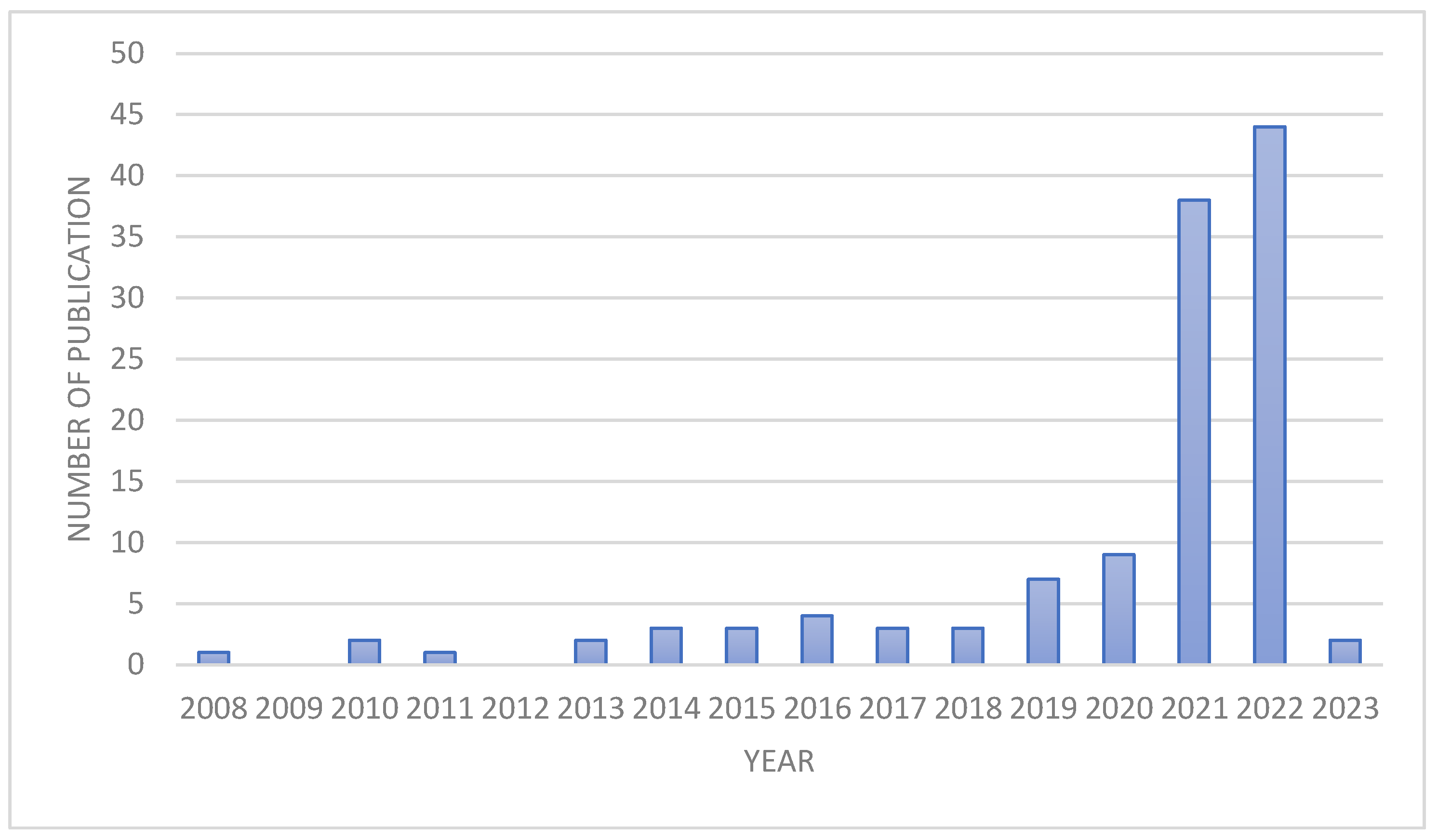
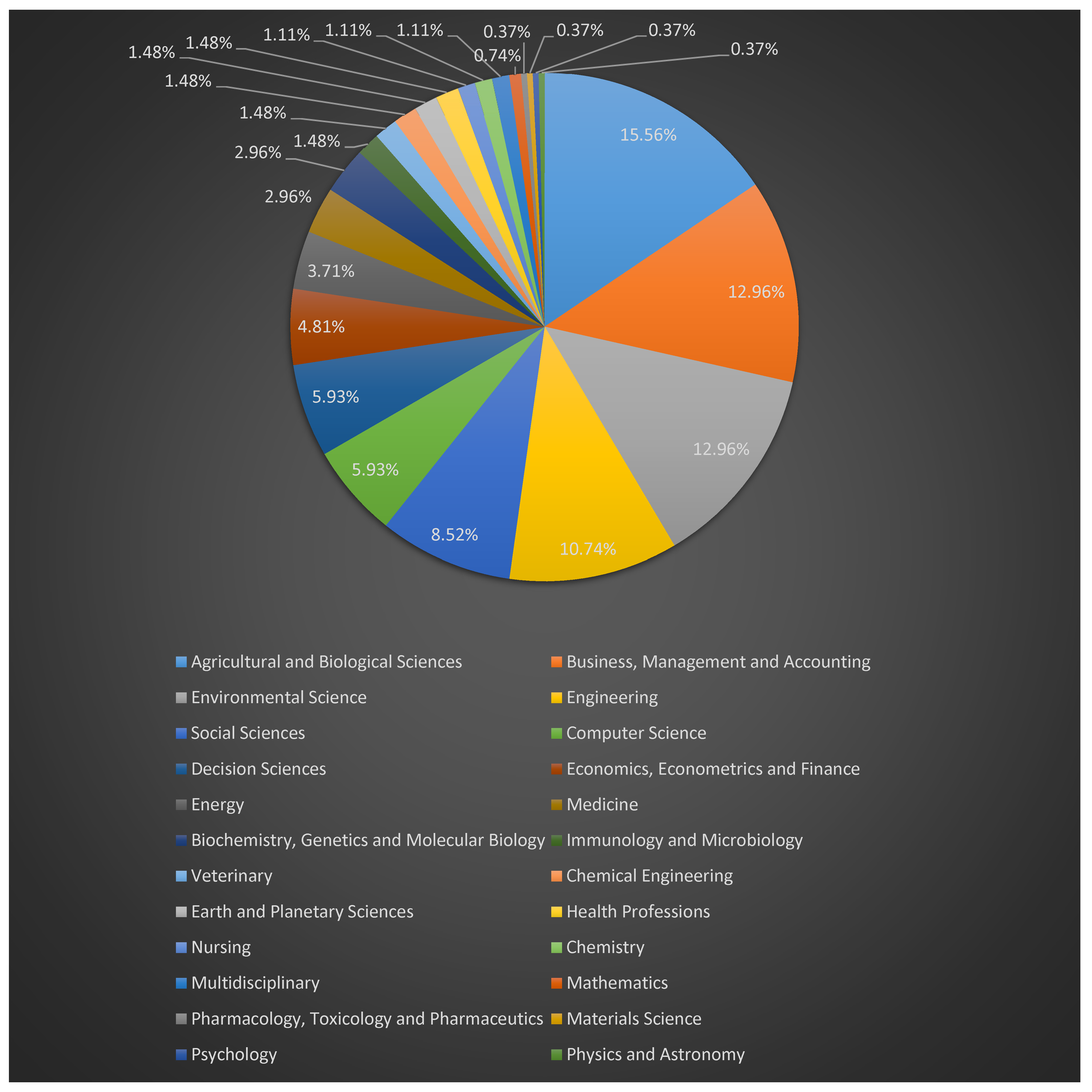
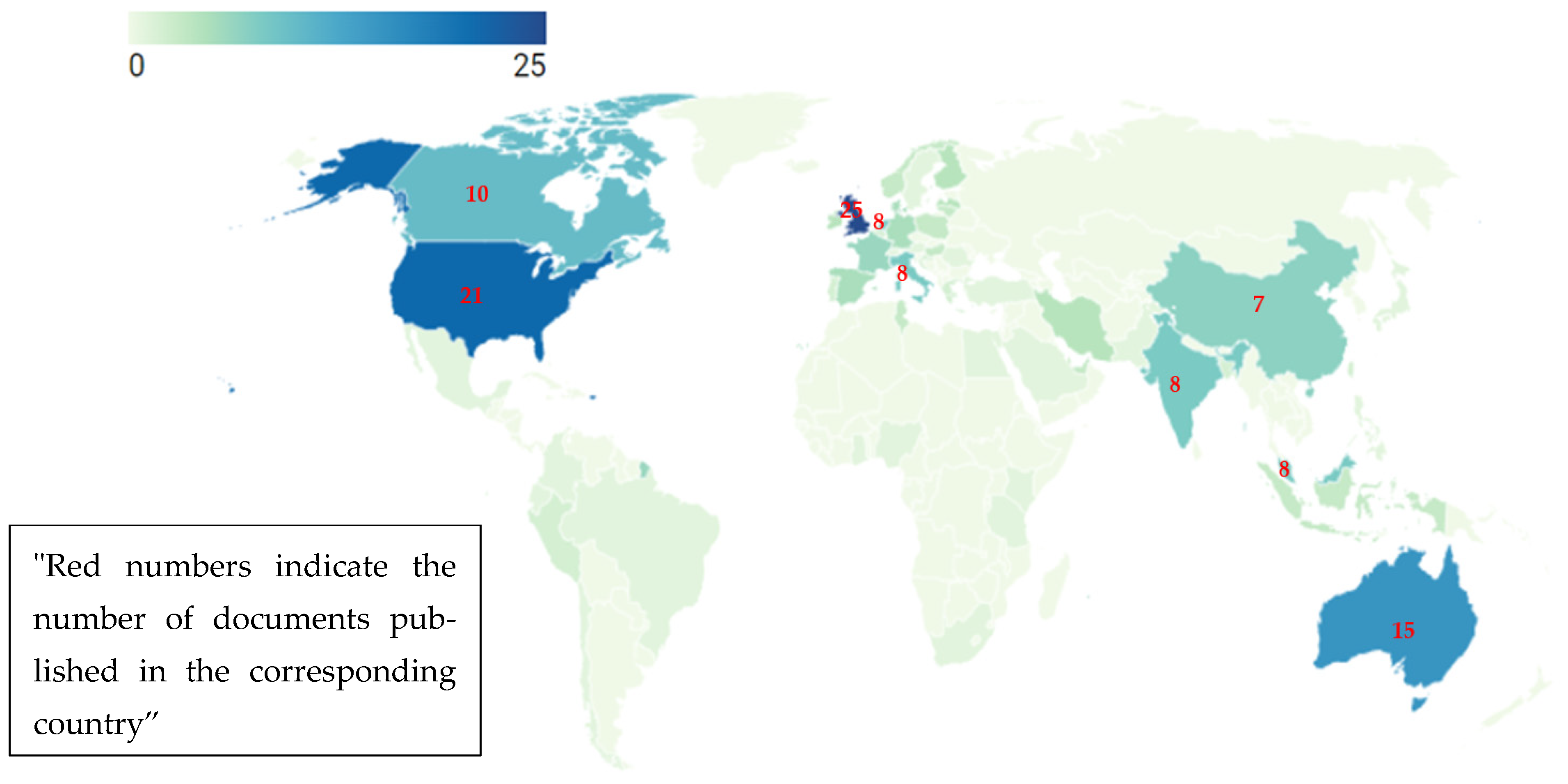
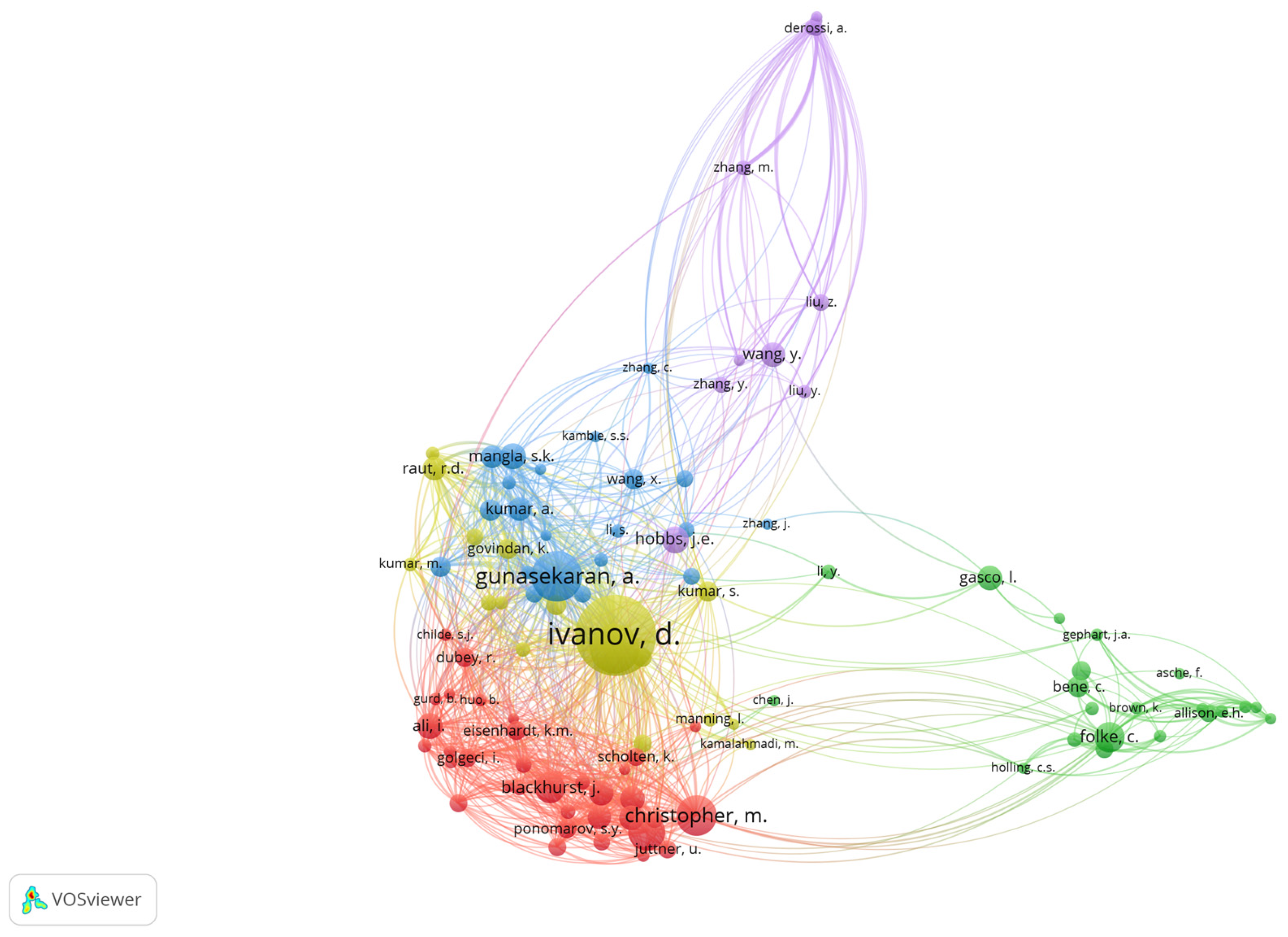
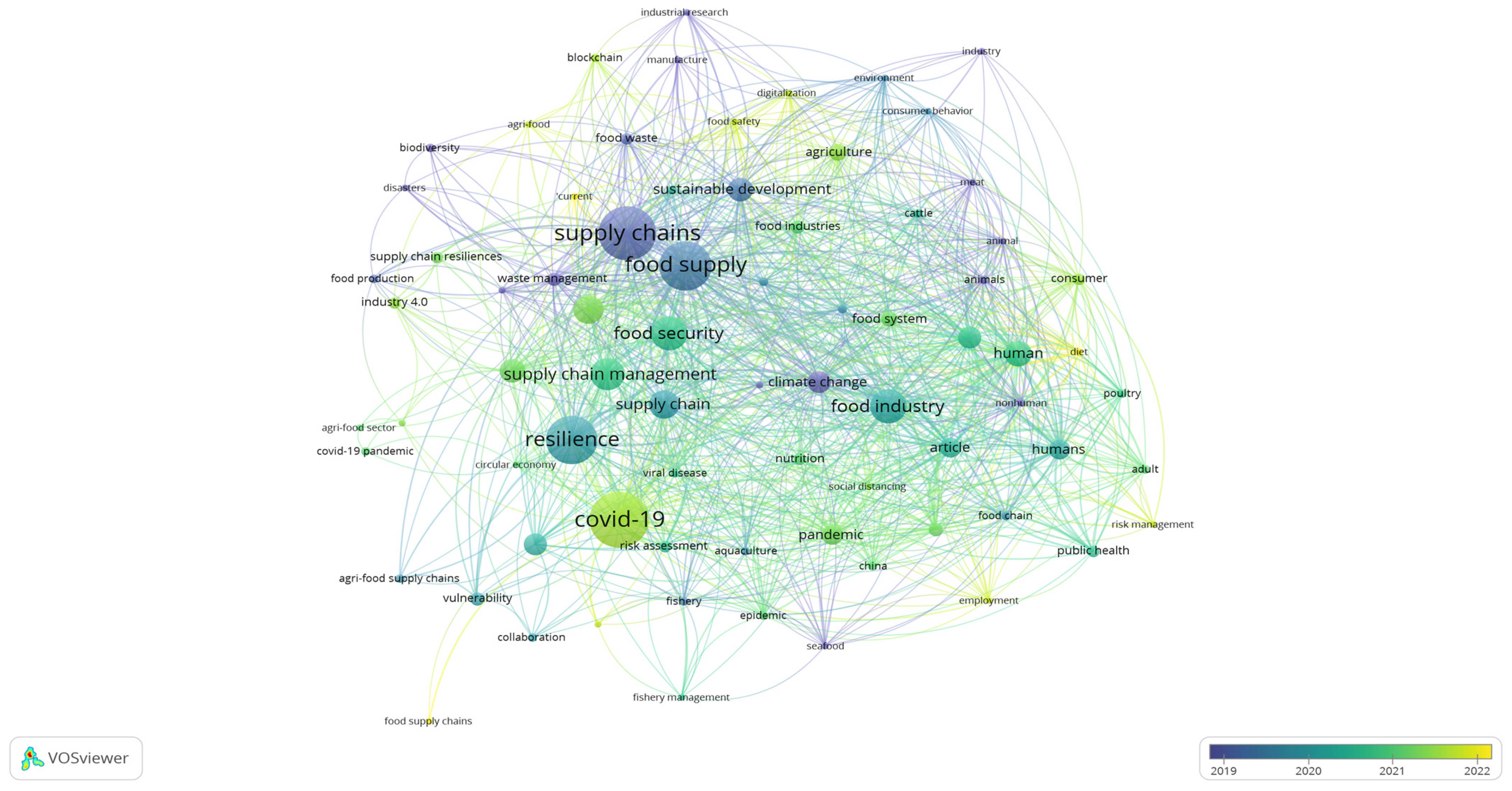
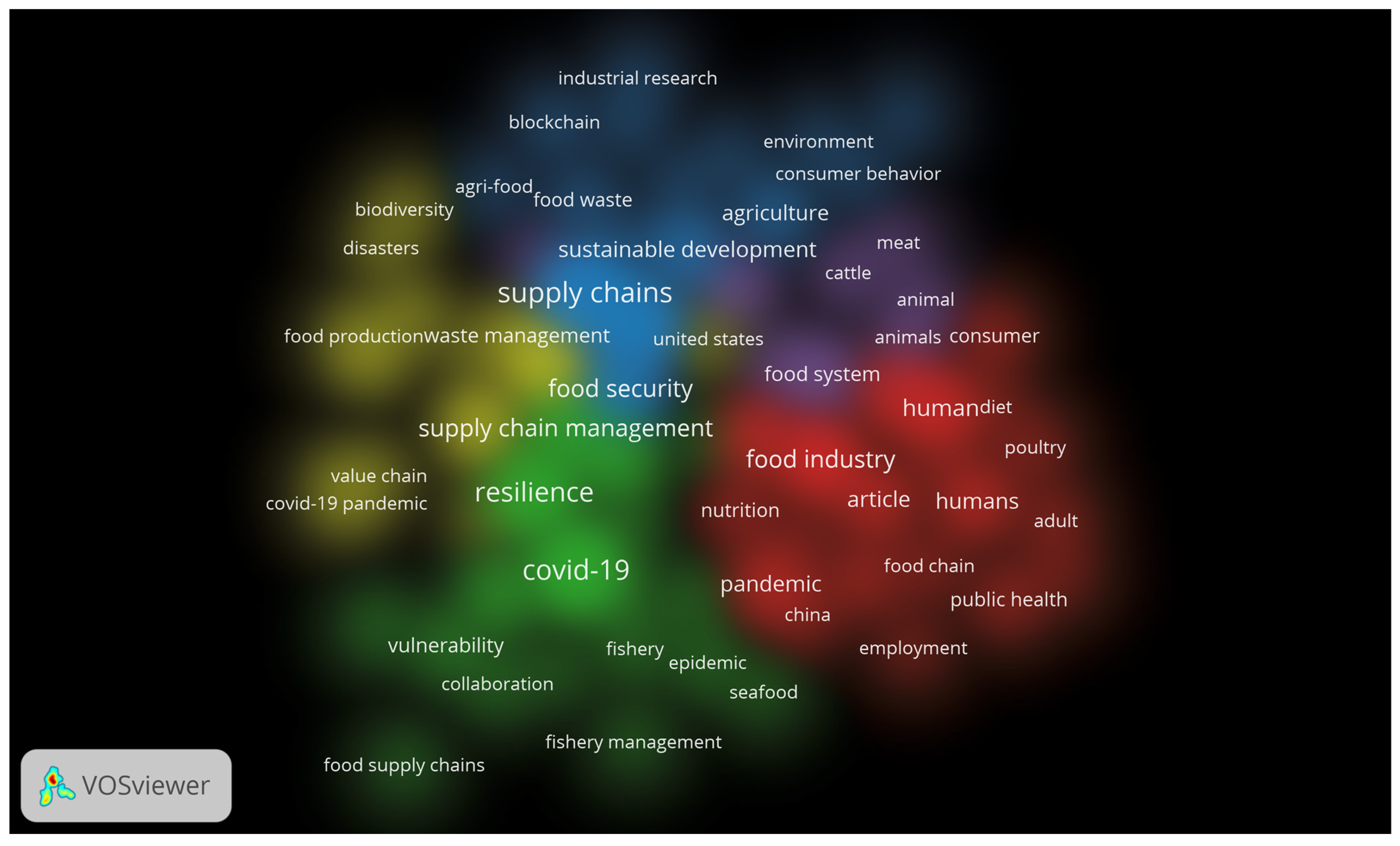
| Source | Publisher | TP | TC | SJR | SNIP | Cite Score |
|---|---|---|---|---|---|---|
| Supply Chain Management | Emerald Publishing | 4 | 653 | 0.27 | 0.22 | 0.33 |
| Sustainability (Switzerland) | Multidisciplinary Digital Publishing Institute (MDPI) | 4 | 25 | 0.267 | 1.066 | 1.65 |
| Agricultural Systems | Elsevier | 3 | 48 | 0.91 | 0.72 | 1.12 |
| Frontiers in Sustainable Food Systems | Frontiers Media SA | 3 | 32 | NA | NA | NA |
| British Food Journal | Emerald Publishing | 3 | 31 | 0.47 | 0.31 | 0.54 |
| Resources, Conservation and Recycling | Elsevier | 2 | 564 | 1.87 | 1.09 | 2.05 |
| Journal of Business Research | Elsevier | 2 | 81 | 3.129 | 2.69 | 3.48 |
| Applied Economic Perspectives and Policy | Oxford University Press | 2 | 64 | NA | NA | NA |
| Trends in Food Science and Technology | Elsevier | 2 | 52 | 3.57 | 3.07 | 4.24 |
| PLoS ONE | Public Library of Science (PLoS) | 2 | 32 | 2.77 | 1.44 | NA |
| Journal of cleaner production | Elsevier | 2 | 28 | 6.05 | 4.39 | 6.96 |
| Document | Citations | Title | Journal |
|---|---|---|---|
| Scholten, K. (2015) | 358 | The role of collaboration in supply chain resilience | Supply Chain Management |
| Sharma, H.B. (2020) | 283 | Challenges, opportunities, and innovations for effective solid waste management during and post COVID-19 pandemic | Resources, Conservation and Recycling |
| Ibn-Mohammed, T. (2021) | 281 | A critical analysis of the impacts of COVID-19 on the global economy and ecosystems and opportunities for circular economy strategies | Resources, Conservation and Recycling |
| Leat, P. (2013) | 153 | Risk and resilience in agri-food supply chains: the case of the ASDA PorkLink supply chain in Scotland | Supply Chain Management |
| Stone, J. (2018) | 133 | Resilience in agri-food supply chains: a critical analysis of the literature and synthesis of a novel framework | Supply Chain Management |
| Khatun, R. (2017) | 117 | Sustainable oil palm industry: the possibilities | Renewable and Sustainable Energy Reviews |
| Xu, Z. (2020) | 107 | Impacts of COVID-19 on global supply chains: facts and perspectives | IEEE Engineering Management Review |
| Tsolakis, N. (2021) | 58 | Supply network design to address United Nations Sustainable Development Goals: A case study of blockchain implementation in Thai fish industry | Journal of Business Research |
| Chenarides, L. (2021) | 51 | COVID-19 and food supply chains | Applied Economic Perspectives and Policy |
| Ali, M.H. (2021) | 50 | Supply chain resilience reactive strategies for food SMEs in coping to COVID-19 crisis | Trends in Food Science and Technology |
| Cluster | Color | 76 Items | Main Items | Cluster Label |
|---|---|---|---|---|
| Cluster 1 | red | 20 items | Human, food industry, public health, diet, food chain, nutrition, pandemic, risk management | Food Systems Resilience and Public Health |
| Cluster 2 | green | 18 items | Supply chain resilience, fishery, seafood, food supply chain, COVID-19, risk assessment | Seafood Supply Chain Resilience and Risk Management |
| Cluster 3 | blue | 16 items | Sustainable development, food security, food safety, food waste, environment, blockchain, digitalization | Digital and Sustainable Food Systems |
| Cluster 4 | yellow | 14 items | Agri-food sector, food production, Industry 4.0, sustainability, disasters | Agri-food Industry 4.0 and Sustainability |
| Cluster 5 | purple | 8 items | Meat, animal, food system, cattle, food industries | Meat Production and the Food Industry |
Disclaimer/Publisher’s Note: The statements, opinions and data contained in all publications are solely those of the individual author(s) and contributor(s) and not of MDPI and/or the editor(s). MDPI and/or the editor(s) disclaim responsibility for any injury to people or property resulting from any ideas, methods, instructions or products referred to in the content. |
© 2023 by the authors. Licensee MDPI, Basel, Switzerland. This article is an open access article distributed under the terms and conditions of the Creative Commons Attribution (CC BY) license (https://creativecommons.org/licenses/by/4.0/).
Share and Cite
Ababou, M.; Chelh, S.; Elhiri, M. A Bibliometric Analysis of the Literature on Food Industry Supply Chain Resilience: Investigating Key Contributors and Global Trends. Sustainability 2023, 15, 8812. https://doi.org/10.3390/su15118812
Ababou M, Chelh S, Elhiri M. A Bibliometric Analysis of the Literature on Food Industry Supply Chain Resilience: Investigating Key Contributors and Global Trends. Sustainability. 2023; 15(11):8812. https://doi.org/10.3390/su15118812
Chicago/Turabian StyleAbabou, Mariame, Sara Chelh, and Mariam Elhiri. 2023. "A Bibliometric Analysis of the Literature on Food Industry Supply Chain Resilience: Investigating Key Contributors and Global Trends" Sustainability 15, no. 11: 8812. https://doi.org/10.3390/su15118812
APA StyleAbabou, M., Chelh, S., & Elhiri, M. (2023). A Bibliometric Analysis of the Literature on Food Industry Supply Chain Resilience: Investigating Key Contributors and Global Trends. Sustainability, 15(11), 8812. https://doi.org/10.3390/su15118812






